Table of Contents
One of the most beautiful dogs in the world takes place in the Samoyed dog breed. These dogs have the most stunning thick white coats that manifest snow; an ever-smiling feature that captivates people; and their well-rounded loving personality that confirms their attractiveness go inside and outside.
In this article, you’ll get to know all there is to discover about this loving dog breed. Keep on reading to be educated about their characteristics, history, behavior, and personality as well as the basic care guide that will equip you; if you’re planning to raise your very own Samoyed dog.
Breed Overview
The samoyed is a breed of medium-sized herding canines that has thick, white, double-layer coats. These dogs are spitz-type dogs that acquired their name from Samoyedic people of Siberia.
Samoyed eyes are black or usually brown and are almond in shape. The ears are thick and covered with fur, erect, and manifest a triangular shape. It is almost always white, but some samoyeds have a light to dark brown tint (called “biscuit”), that resides around the tip of their ears. Samoyed owns the famous Samoyed smile; which is made possible by their upward curling lips, even when their mouth is closed, they seemingly grace everyone’s positivity.
Other Features
Discussing their tail, it is one of the breed’s outstanding features. The tail is carried curled over the back, resembling Alaskan malamutes. Adorably, Samoyeds sleep with their tails over their noses in cold weather, this gives them additional warmth. Samoyeds allow their tails to fall if they are at ease and calm; but return it to curl when it needs to be alert and when feeling uneasy, threatened, and frightened.
And the star of the show, their coat. Samoyed has a dense, double-layer coat. The topcoat contains long, coarse, and level guard hairs that appear opaque white but actually have a tint of silver coloring. This topcoat keeps the undercoat clean and free of debris. The undercoat, on the other hand, consists of dense, soft, and short fur that provides warmth for these gentle dogs. The undercoat sheds heavily once or twice a year; and fine hairs shed all year round and have a tendency to stick in clothing, furniture and catch it floating in the air. For Samoyed owners, grooming is a must. The standard breed may come in a mixture of biscuit and white hue, although pure white is really common. Males generally have larger ruffs than females.
Lastly, while this breed is hypoallergenic; it may still produce fewer allergens, which is why it needs to be considered by extremely allergy-sensitive individuals.
History of Samoyed Dogs
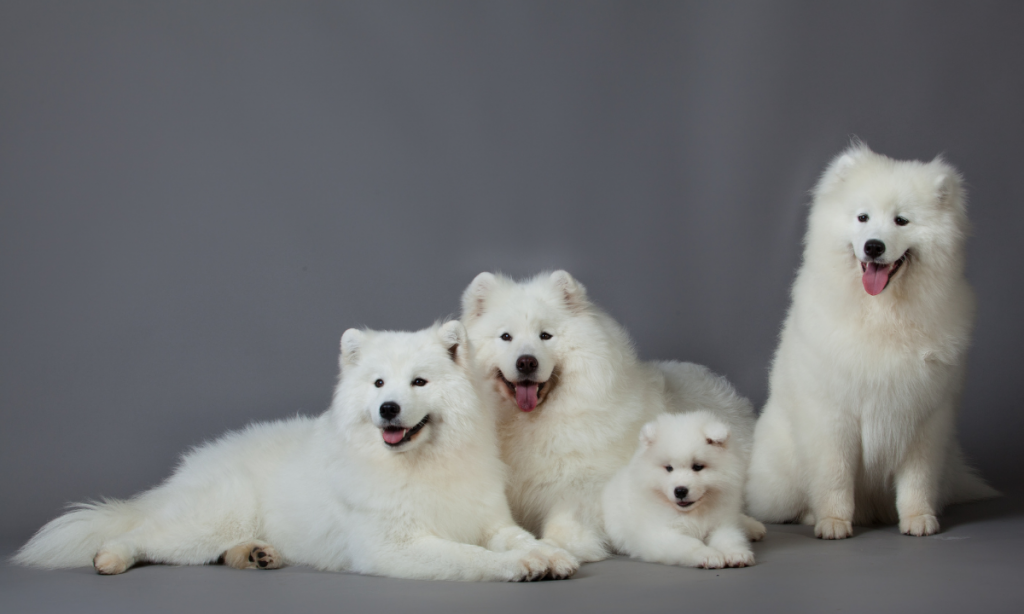
Samoyeds were originally bred to hunt, herd reindeer, and haul sleds for the Samoyede tribe they served in Northwestern Siberia. The tribesmen were peaceful nomads that manifest extraordinary affection for these beautiful dogs, treating them as one of their own. Because of this, Samoyeds have developed a love; and understanding of humankind, and the unfailing sense of trust and faithfulness retained in the breed, up until now. These gentle snow in dog form. Remained delightful playmates and faithful protectors, of all families and all people of different ages.
They were brought out of their homeland at the end of the 19th century; and the early part of the 20th century, for them to be responsible for pulling sleds on Arctic and Antarctic voyages. These valiant dogs endured terrible hardships, unfailingly serving men in their quest for the poles. Only a few have returned. Samoyeds are confirmed powerful, gentle, and magnificent, and the epitome of a truly hard-working dog.
Samoyeds in Europe and USA
Moving forward, most of their strains in England and the United States fall from the veteran expedition sled dogs. It is known that the first American Samoyed is a Russian import. It was registered with the aid of AKC the year 1906, however, most present-day American breeds of Samoyeds trace their forefathers to the dogs; that were imported after the first world war.
If we can observe, they have an extremely arctic heritage, but it is impressive of them as they have adapted well to warmer climates. Samoyeds seem to do just fine in tolerating heat in Florida, Texas; and Southern California, the three of which are the hottest states of the U.S.
Present Time
Subsequently, because of how tolerant they were of various climates, trades, and breeding of this dog begins to grow. With the rise of media, they became the center of attraction because of celebrities that showcase their attractiveness on their social media. The breed also became a buzz trend, with hashtags like Samoyed smile, that celebrate their endearing beam. To this day, Samoyed’s renowned reputation became an intelligent, dignified, and loving family dog, which most argue that they are the most ideal for it.
Behaviors and Personality
Samoyeds are gentle and dependable. They are gentle in the sense that they are very friendly, loving and do not get aggressive at all, unlike other dog breeds. They are quiet and very welcoming of people. Dependable; as they can be a protector of children, adults, and the elderlies, you can be certain that you’ll have a faithful companion with them. Samoyeds’ are renowned outstanding family dogs, because they work well with families as their endearing traits always sync well with people. They are great babysitters, helpers, obedient, and just generally a great addition to any household.
They are affectionate, and it will always show. These dogs get excited and go around wagging their tail at their favorite people. They love cuddling, petting, playing, and more importantly for busy people, silence observation. You really must pay time of the day for these dogs, because of their highly sociable nature, if not entertained, they can be anxious and destructive.
Loyal and Intelligent Dogs
They are faithful, resembling a very much golden retrievers’ loyalty. They are able to foster bond relationships with their human owner and with their vulnerability to do so, really makes them one of the most liked dog breeds to exist.
One thing that is also impressive in these attractive canines is their intelligence. They are easily trainable and enjoy mental stimulation. It is advisable that training must occur when they are young to mold their personality to be docile, which in most cases holds truth. Samoyeds are active and need daily exercise. With their intelligence, and them being attuned with people, they really ought to perform with obedience. They are competitive and do well in dog sports such as agility, herding, and rally,
Lastly, they do well with other animals. Be it one of their own, other dog breeds, cats, or exotic kinds of animals.
Basic Care Guide for a Samoyed
Part 1: Grooming
Laying proper equipment and setting aside time.
Samoyeds have two-layer coats; a fine undercoat that keeps them warm and an outer coat that protects them from the weather. To maintain it, you need to comb and brush your very own several times a week with the right kind of tools.
- You must invest in a rake or comb that has rotating teeth, this will help to glide through their coat easily and a pin brush that has rounded ends that will aid in preventing you from scratching and hurting your dog while grooming.
Groom using a comb or a rake first.
You are to use your one hand to part the hair and section it; with your other combing the hair in the direction of hair growth. Keep on doing it for each section until no more hair is falling off.
- As it can take time to completely comb your Samoyed; you are to implement breaks for playtime throughout the grooming process.
- You can also provide positive feedback on your dog; like telling them how good they are, so they remain calm and gentle.
Finish with the brush.
Brush the top coat to aid in the smoothness of the coat. Brushing must exist daily, as this aids in eliminating loose, dead hair.
- Only use a brush in your dog’s tail, as it is a sensitive area. To do so; hold the tip of the tail as gently as you can in one hand while brushing it with the other.
Check for health issues in process of grooming
Bathe your dog, cut their nails, brush their teeth. This is weekly maintenance and accounts greatly for their optimum health condition. Hygiene must not be overlooked.
Part 2: Feeding and Exercise Needs of your Samoyed
Feed based on your dog’s age.
Samoyed puppies or adults need to eat varying amounts several times throughout their day. Aid to it.
- Samoyed puppies aged 2-3 typically eat about one-half cup of kibble mixed with water, thrice a day in decent amounts.
- Young Samoyeds are not great eaters and often require to be allured to eat with meat juices or bacon grease added to their meal.
- Reaching three months, they typically eat dry kibble, twice a day.
- Older than 1 year, Samoyed is best fed twice a day with premium dog food made healthy for their growth.
Overfeeding must refrain.
It is scientifically proven that your Samoyed will live a longer and happier life if they conserve a healthy weight. If you notice your dog getting heavier, you must decrease the amount you are feeding them and supplement them with extra time for exercise.
Provide adequate exercise for your Samoyed.
This breed is active and has lots of energy stored in them, to stimulate, you must provide them with physical activities such as active playtime, and long walks. They also are a great companion for hikes and bike rides.
Part 3: Socializing and Building Connection with your Samoyed
Make sure your Samoyed is included in your family.
This breed is extremely social, and they manifest friendliness. That is why it is important that you, together with your family, foster a relationship with it. Samoyeds are excellent companions with people of every age; and with their attractive physical attributes, it is almost non-existent that some will not want to be around them.
Train your Samoyed on their blooming age.
We all know that they are intelligent and without training and as they get older, they can become stubborn. By establishing clear rules while you are young, and asserting that you are in charge; they will grow to have a docile demeanor and you two will have a smooth relationship.
- If you do not want your dog on your bed as an adult, you must not allow it as a puppy.
- Consider a socialization class for your Samoyed puppy and you; as it can teach how the both of you can relate to each other and have an effective working connection. As an owner, you will learn how to be fair and consistent, and effective in executing voice commands.
Declare your role as the pack leader.
Samoyeds are packed-oriented, it is their nature. They will look for a leader, otherwise, they will assume the role themselves. To establish your authority, in doing things, you must have signals before he starts doing it too, for instance; in eating. With these three parts, the most important practice you can implement is to do it with genuine love and care. With these two great intentions, caring for them will not feel like a chore nor responsibility; but a voluntary act that is ingrained in your nature.
Health Concerns for Samoyeds
Samoyeds have an impressive immune system and thus are generally healthy. However, with all breeds of dogs, this specific breed is prone to certain health conditions. It is to be noted that not all Samoyed dog will get any if not all of these diseases; but it is vital to be aware of them if you are to raise one of them.
Glaucoma
Glaucoma is increased pressure in the eyes and manifests in two forms: primary, which is hereditary and innate, and secondary, which is caused by decreased fluid onto the eyes typical due to other eye diseases. Symptoms of it are vision loss and pain; and the treatment and prognosis of it differ depending on the type and other health considerations of the Samoyed. Glaucoma can be mainly treated surgically or with topical eye drops.
Hip Dysplasia
This disease is an inherited condition in which the thigh bone does not seemingly fit into the hip joint. Some dogs that are suffering from this tend to show pain and lameness on either one or both rear legs; while some do not display any outward signs of discomfort. Remember, X-Ray screening is the most certain way to validate and diagnose the problem.
Arthritis can develop in hip dysplasia as the dog ages. So if you are to own a Samoyed dog puppy; the breeder you ought to buy it must have proof that its parents have been tested for this condition and are free of difficulties.
Samoyed Hereditary Glomerulopathy
This is a genetic disease, primarily targeting a dog’s kidney. The condition is more severe in male samoyed dog who appear healthy for the first three month of their life until the symptoms begin appearing and progressing. Death from renal failure typically resides by 15 months of age.
Females typically acquire mild symptoms of this at 2 to 3 months of age but do not suffer from renal failure. Until this day and age of advancement, unfortunately; there is still no genetic screening test available for Samoyed Hereditary Glomerulopathy, but the research is ongoing and hopeful.
Patellar Luxation
Also referred to as slipped stifles, Patellar Luxation is a common problem occurring in small dogs. The knee cap is known to be the patella. Luxation refers to the dislocation of an anatomical part, the bone at a joint. Patellar luxation, then, means when the knee joint slides in and out of place, which results in pain and discomfort. This can also be rippling, although thankfully many dogs can lead relatively normal lives, amidst this condition.
Hypothyroidism
This is a disorder targeting a dog’s thyroid gland. It is the disease responsible for conditions such as epilepsy, alopecia, obesity, lethargy as well as pyoderma; and other unfortunate skin conditions. Hypothyroidism is typically aided with medication, diet, and lifestyle modification.
Diabetes Mellitus (DM)
Dm is a condition in which the body cannot regulate its blood sugar levels. A diabetic dog will exhibit a great and healthy appetite however will lose weight because the food consumed will not be used efficiently. Symptoms of this disease are excessive urination and thirst, increased appetite paired with weight loss, and lethargy. DM is managed through diet and lifestyle modification, as well as the administration of insulin.
Progressive Retinal Atrophy (PRA)
This is known to be a family of eye diseases that circulates around the gradual deterioration of the retina. Early in the disease, affected dogs experience night blindness, and total blindness as the disease progresses. Fortunately, many dogs adapt well to the loss of vision, as long as they have support; and they are made familiarized with the environment they belong to.
Subvalvular Aortic Stenosis
Subvalvular Aortic Stenosis: is a heart problem; that is caused by a narrow link between the left ventricle and the aorta. This causes fainting that takes place several times each month and, in unfortunate cases, sudden death.
Cancer
Cancer symptoms in dogs manifest as abnormal swelling of a sore; sores that do not heal, bleeding from any body part’s opening, and difficulty in breathing. It is treated mainly by chemotherapy, surgery as well as medications, and lifestyle modifications.
Samoyed Dog Breed Frequently Asked Questions
Are Samoyeds good for first-time dog owners?
A breed that has low maintenance needs is always the right option for a first-time dog owner; and Samoyed does not have that. Samoyed has moderate grooming and exercise needs that might be overwhelming for first-timers to endure.
Do Samoyeds heavily drool?
No, Samoyed dog mostly drool when they are only hungry; or when they have just finished a big meal, but apart from those, these dogs are not known to salivate that much.
Samoyed’s lifespan?
Samoyeds have a decent average lifespan of 13 years. But with proper care, impressive nutrition, and exercise, some experts say it might even live longer. So, just abide by that, and you two will be looking forward to long years of great companionship.
Do Samoyeds make great guard dogs?
Unfortunately, no, because they are extremely welcoming of other people, even strangers.
Are Samoyeds appropriate for apartment living?
Yes! Samoyed dog are a great fit for the apartment lifestyle because they are highly adaptable and able to mold their needs in compromised instances.
Can Samoyeds be left alone?
Sadly, no, as they are highly dependent on their family members and loved ones. They require attention, but luckily, just allowing them to observe you while you are busy is considerable for their well-being instead of completely shutting them down. If shut down, they can be sad, frustrated, and unmotivated. Thus, if you are in need of a dog breed that can be left alone and be self-sufficient, Samoyed is definitely not the right one for you.
Do Samoyeds get along with children, other dogs, and cats?
Yes, yes, and yes! Samoyeds are an excellent breed for children because they are gentle and careful towards them, and they enjoy having to play with a lot of kids with them. Secondly, they are highly warm and affectionate towards another canine. These dogs have no problem sharing their foods and toys with other dogs, that is why it will not be a problem with those that want Samoyed as an addition to his or her growing dog family. Lastly, they remain friendly with cats so long that cats are friendly and nice to them.
Conclusion
Samoyed dog undoubtedly are a very interesting, if not, impressive dog breed. I am convinced that their attractiveness really takes place both inside and outside. Their impressive and endearing physical attributes and their lovely personality is one that will really captivate dog lovers or people in general.
If you had liked what you’ve read, it is safe to assume that you are now making the decision of acquiring one for your own, and may this be a yes that you need in caring for a Samoyed dog. Do remember, to assess your capacity and approach dog parenting as a very serious journey to partake, as no one but you will be responsible for making sure your dog gets the best and finest quality of life.

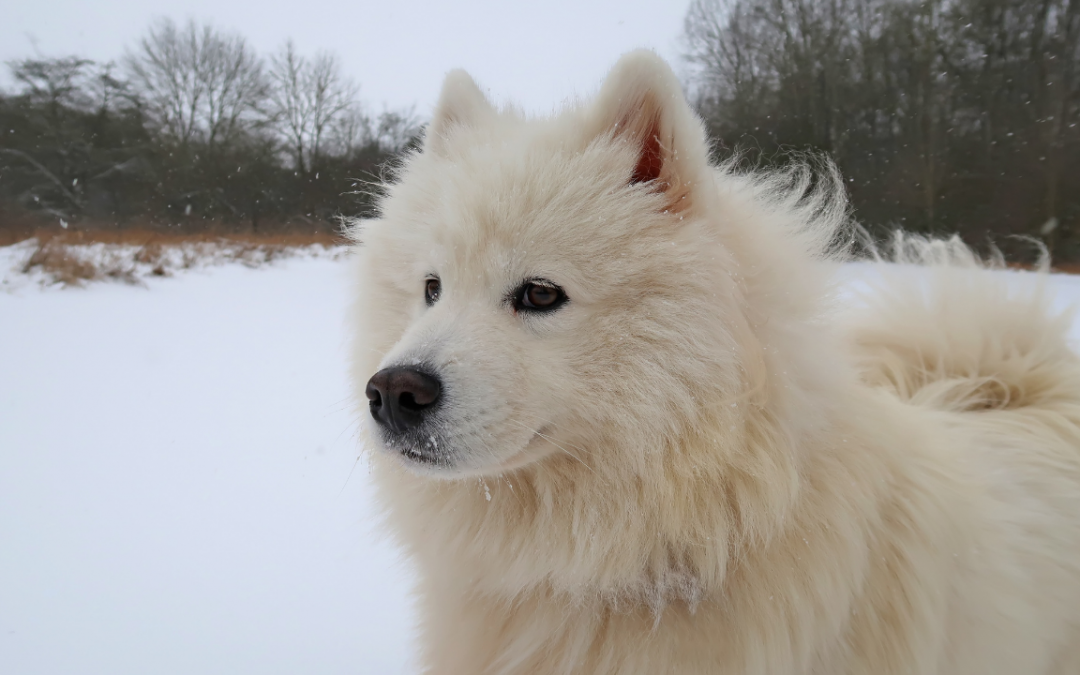
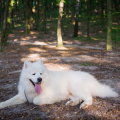
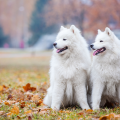

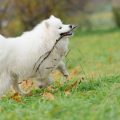
 Author and long-time animal lover. Sharing knowledge on pet care through experience and the written word.
Author and long-time animal lover. Sharing knowledge on pet care through experience and the written word.